When the former Soviet Union invaded Afghanistan in the early 1980s, one of the last acts of the Carter Administration was to implement a limited military draft that today still funds the U.S. Selective Service System and THE DRAFT collecting personal data on young Americans 18 and over, although the political possibility of conscription appears to be highly unlikely unless the Pentagon begins to run out of too many of our gallant volunteers.
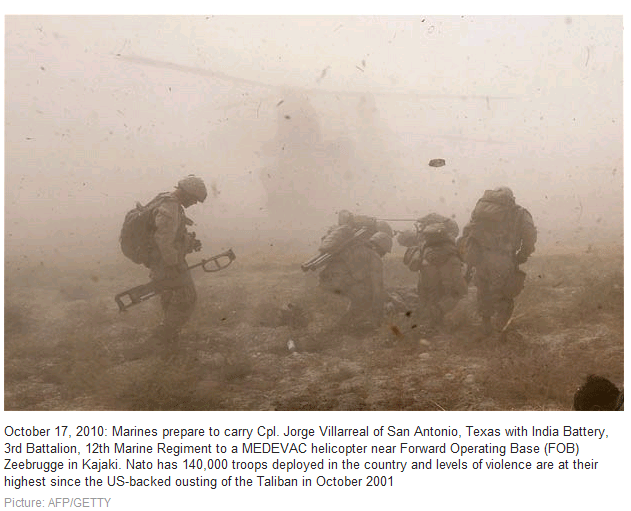
Today our own invasion (well liberation if you prefer), and occupation of Afghanistan officially surpassed the Soviet’s failed attempt.
In recognition of this historic milestone I have decide to write about the downside of our occupation (liberation) of Afghanistan and the latest official U.S. Report on Progress Toward Security and Stability in Afghanistan highlighting the contrast.
Robert L. Hanafin, Major, U.S. Air Force-Retired, GS-14, U.S. Civil Service-Retired, Veterans Issues Editor, VT News Network
VT is a full service network of 63 web sites that service the U.S. Military Veterans and Family Community. With over 390,000 plus unique visitors per month bringing in over 22,000,000 page hits, we’re growing into a dynamic interactive conglomerate of information, service, and product sites serving the U.S. Military Veterans market. Created in 2004, Our “VT” brand name is growing and gaining mass acceptance in this niche marketplace.
Nine years, 50 days US presence in Afghanistan surpasses failed Soviet occupation
Extract from article by AP Reporter Patrick Quinn, Thursday, 25 Nov
The Soviet Union couldn’t win in Afghanistan, and now the U. S. is about to have something in common with that futile campaign: nine years, 50 days.
Today, the U.S.-led coalition will have been fighting in this South Asian country for as long as the Soviets did in their humbling attempt to build up a socialist state. The two invasions had different goals, and dramatically different body counts, but whether they have significantly different outcomes remains to be seen.
What started out as a quick war on 7 Oct 2001, by the U.S. and its allies to wipe out al-Qaida leader Osama bin Laden and the Taliban has instead turned into a long and slogging campaign. Now about 100,000 NATO troops are fighting a burgeoning insurgency while trying to support and cultivate [an experiment in] democracy.
A Pentagon-led assessment released earlier this week [see Executive Summary below] described the progress made since the U. S. injected 30,000 more troops into Afghanistan earlier this year as fragile.
NATO’s core objective is to ensure that Afghanistan “is never again a sanctuary to al-Qaida that it was prior to 9/11.”
The top U.S. military commander in Afghanistan, Gen. David Petraeus, has said NATO’s core objective is to ensure that Afghanistan “is never again a sanctuary to al-Qaida or other transnational extremists that it was prior to 9/11.”
He said the only way to achieve that goal is “to help Afghanistan develop the ability to secure and govern itself. “To a level that is good enough for Afghanistan.”
Ongoing effort to get the Taliban to the negotiating table
To reach that, there is an ongoing effort to get the Taliban to the negotiating table. President Hamid Karzai has set up a committee to try to make peace, and the military hopes its campaign will help force the insurgents to seek a deal.
When the Soviet Union invaded Afghanistan on 27 Dec 1979, its stated goal was to transform Afghanistan into a modern socialist state. The Soviets sought to prop up a communist regime that was facing a popular uprising, but left largely defeated on 15 Feb 1989.
In 1992, the pro-Moscow government of Mohammad Najibullah collapsed and U.S.-backed rebels took power. The Taliban eventually seized Kabul after a violent civil war that killed thousands more. It ruled with a strict interpretation of Islamic law until it was ousted by the U.S.-led invasion.
Nader Nadery, an Afghan analyst who has studied the Soviet and U.S. invasions, said “the time may be the same” for the two conflicts, “but conditions are not similar.”
More than a million civilians died as Soviet forces propping up the government of Babrak Karmal waged a massive war against anti-communist mujahedeen forces.
“There was indiscriminate mass bombardment of villages for the eviction of mujahedeen,” Nadery said. “Civilian casualties are not at all comparable.”
Michael O’Hanlon, a senior fellow at the Brookings Institution think tank and Afghanistan expert, said NATO forces have killed fewer than 10,000 civilians and a comparable number of insurgents.
The allied military presence has also been far smaller and more targeted. Even now, nearly all operations are restricted to the south and east of the country where the insurgency is most active. O’Hanlon points out that at the height of the resistance, there were 250,000 mujahedeen representing all Afghan ethnic groups fighting the Soviets, while “the current insurgency is perhaps one-eighth as large and is only Pashtun.”
“We do have big problems. But there is no comparison between this war and what the Soviets wrought,” he said.
“The Soviet war set Afghanistan back dramatically from what had been a weak but functioning state. NATO has, by contrast, helped Afghanistan to a 10 percent annual economic growth rate, 7 a million kids are now in school, and most people have access to basic health care within a two-hour walk,” O’Hanlon said.
He also points out that although Karzai was hand-picked by the United States after the invasion “he has since been elected twice by his own people.”
The U. S. and its allies, however, have made strategic mistakes
Such as taking their eyes off Afghanistan and shifting their attention to the war in Iraq. In those crucial years, the Taliban and their allies surged back and took control of many parts of the Afghan countryside and some regions in the south — especially parts of Kandahar and Helmand.
Wadir Safi, a professor at Kabul University who served as civil aviation minister under the Najibullah government, said risks surround the U.S. effort because “the Americans never reached the goal for which they came.”
“If they don’t change their policy, if they don’t reach their goals, if they don’t reach agreement with the armed opposition and with the government, then it is not a far time that the Afghan people will be fed up with the presence of these foreign forces,” Safi said.
2014 date when NATO forces are supposed to transition to a noncombat role.
The U. S. has pledged that its commitment to Afghanistan will run past the 2014 date when NATO forces are supposed to transition to a noncombat role.
A Russian analyst said the Soviet Union tried to do something similar when it left Afghanistan. It backed Najibullah with money and weapons, and left behind a trained and heavily armed Afghan military. But it all crumbled and the mujahedeen took over Kabul in 1992. Najibullah stayed in the city’s U.N. compound until Kabul fell to the Taliban in 1996, and he was hung from the main square.
“The Soviet Union tried to leave its protégé alone to run the country, but that ended in the Taliban victory,” said Alexander Konovalov, the head of the Moscow-based Institute of Strategic Assessment, an independent think-tank.
“The U.S. now wants to create a self-sufficient structure behind backed by some support forces,” he said. “It remains to be seen how successful it could be in Afghanistan.”
On a more satirical note, in his article The US of A Breaks the Soviet Record, Salon’s Glenn Greenwald takes a somewhat humorous approach to our progress in Afghanistan.
Source: 26 Nov 2010 “Salon” — Even for the humble among us… some national achievements are so grand that they merit a moment of pride and celebration:
US presence in Afghanistan [surpasses] Soviet
The Soviet Union couldn’t win in Afghanistan, and now the U. S. is about to have something in common with that futile campaign: nine years, 50 day and counting.
On 26 Nov 2010, the U.S.-led coalition will be fighting in this South Asian country for as long as the Soviets did in their humbling attempt to build up a socialist state.
It’s vital that we stop the threat of Terrorism [over there despite the never ending story of potential or failed terrorist threats and attacks over here] and nothing helps to do that like spending a full decade, and counting, invading, occupying, and bombing Muslim countries.
It seems clear that a similar, or even grander, prize awaits us as the one the Soviets were rewarded. Greenwald hopes nobody thinks that just because we can’t identify who the Taliban leaders are after almost a decade over there that this somehow calls into doubts our ability to magically re-make that nation [into whatever image of a democratic state is on our politicians minds at any one time – talk about CHANGE]. Even if it did, it’s vital that we stop the threat of Terrorism, and nothing helps to do that like spending a full decade, and counting, invading, occupying, and bombing Muslim countries.
VT Editorial Comment: Re-make that nation into whatever image of a democratic state is on our politicians’ and military leaders’ minds at any given time – talk about CHANGE that image of democracy is just about as elusive as finding Osama Bin Laden, dead or alive].
The good news- Our Government’s appetite for endless war in the Muslim World has not diminished.
Beyond our shattering this record and thus showing that we can still kick those Soviets around even after they no longer exist, is that this decade of utter futility hasn’t at all diminished the Government’s appetite for endless war in the Muslim world.
– By all accounts, the [Obama] administration its actively debating whether to accelerate its already escalated intervention in Yemen.
– We’ve dramatically increased our covert actions in countless countries across the Muslim world.
– And former Bush State Department legal adviser John Bellinger III (one of the “moderates” from that era) argues in The Washington Post for a re-writing of the 2001 Authorization for the Use of Military Force (AUMF) — not in order to rescind it after nine years of endless war-fighting, but rather to expand it, on the grounds that it “provides insufficient authority for our military and intelligence personnel to conduct counterterrorism operations today” and outrageously fails to empower the President’s “wish to target or detain a terrorist who is not part of al-Qaeda” (for good measure, he also wants the new law to authorize the killing of American citizens and to allow detention without charges.
Now that will make the Tea Party happy (wink).
Clearly, the AUMF is far too narrow and weak for our purposes since, as Bellinger notes, this is all we’ve been able to do in its name. The Bush and Obama administrations have relied on this authority to:
– wage the ground war in Afghanistan;
– to exert lethal force (including drone strikes) against al-Qaeda leaders in Pakistan, Yemen and Somalia;
– and to detain suspected al-Qaeda and Taliban members in Guantanamo Bay, Cuba, and Afghanistan.
What kind of lame AUMF is that?
A decade’s worth of war, some slaughtering through the use of remote-controlled sky robots over a few countries, and a worldwide regime of lawless detention (to Stay Safe)?
How are we supposed to Stay Safe [over here or over there] when we tie one arm behind our back that way?
Expanded Endless War(s) because America is Financially Strong!
That’s right when it comes to foreign policy – America is Financially Strong. Tell that to the unemployed who seriously think they have no role to play in these wars. They have yet to realize that unless they join the Army or Marines, they surely will remain unemployed despite America being Financially Strong.
The Vision of Expanded Endless War instead of CHANGE
Fortunately, if this vision of Expanded Endless War proves to be unwise, the harm will be contained, since the U.S. (unlike the former Soviet Union) is so financially strong that it can easily sustain this. And whatever else is true, there’s one thing we should all be able to agree on: the person presiding over all of this deserves the Nobel Peace Prize.
UPDATE: In a New York Times article on the possibility that many newly elected Tea Party candidates will dare to include military spending in demanded budget cuts and will be similarly hostile to foreign aid — including, most alarmingly for some, to Israel — the following passage appears (h/t Matt Duss):
“One of the first things Congressman Cantor can do is to make sure that his colleagues vote for aid to Israel,” said Senator Charles E. Schumer, Democrat of New York, who also met with Mr. Netanyahu.
In the face of all these economic difficulties, austerity measures, and calls for Endless War, it’s comforting that at least some of America’s representatives in Congress — such as the Good Democrat Chuck Schumer — have their priorities [Israel] straight.
VT Editorial Comment: In contrast to the satirical Salon take on passing an historic milestone in Afghanistan provided by Glenn Greenwald above, we have a more serious and sobering official U.S. government version of ‘progress in Afghanistan’ presented by our government as if they were going to present anything other than PROGRESS. This is the official Pentagon version although several other executive agencies have contributed. BTW there is nothing satirical about this report.
Report on Progress Toward Security and Stability in Afghanistan
November 2010 [Covering period of April 1, 2010 to September 30, 2010]
Report to Congress [Next report will cover October 1, 2010 to March 31, 2011]
In accordance with the Defense Authorization Act for Fiscal Year 2008, as amended
Executive Summary
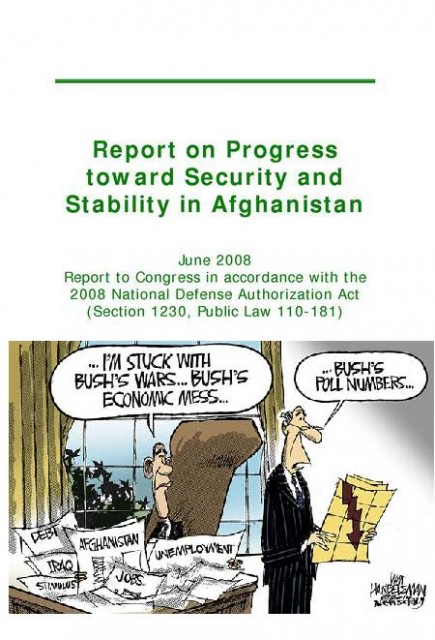 This report to Congress is submitted consistent with the Defense Authorization Act for Fiscal Year 2008 as amended by the Defense Authorization Act for Fiscal Year 2010. It includes a description of the strategy of the U. S. for security and stability in Afghanistan. This report is the fourth in a series of reports required every 180 days through fiscal year 2010 and has been prepared in coordination with the Secretary of State, the Director of National Intelligence, the Attorney General, the Administrator of the Drug Enforcement Administration, the Administrator of the United States Agency for International Development, and the Secretary of Agriculture. This assessment complements other reports and information about Afghanistan provided to the Congress; however, it is not intended as a single source of all information about the combined efforts or the future strategy of the United States, its Coalition Partners, or Afghanistan. The information contained in this report is current as of September 30, 2010.
This report to Congress is submitted consistent with the Defense Authorization Act for Fiscal Year 2008 as amended by the Defense Authorization Act for Fiscal Year 2010. It includes a description of the strategy of the U. S. for security and stability in Afghanistan. This report is the fourth in a series of reports required every 180 days through fiscal year 2010 and has been prepared in coordination with the Secretary of State, the Director of National Intelligence, the Attorney General, the Administrator of the Drug Enforcement Administration, the Administrator of the United States Agency for International Development, and the Secretary of Agriculture. This assessment complements other reports and information about Afghanistan provided to the Congress; however, it is not intended as a single source of all information about the combined efforts or the future strategy of the United States, its Coalition Partners, or Afghanistan. The information contained in this report is current as of September 30, 2010.
NOTE: This is a historical document that covers progress made in Afghanistan from April 1, 2010 to September 30, 2010. The next report will include an analysis of progress toward security and stability from October 1, 2010 to March 31, 2011.
Progress across the country remains uneven, with modest gains in security, governance, and development in operational priority areas. The deliberate application of our strategy is beginning to have cumulative effects and security is slowly beginning to expand.
Although significant challenges exist, some signs of progress are evident.
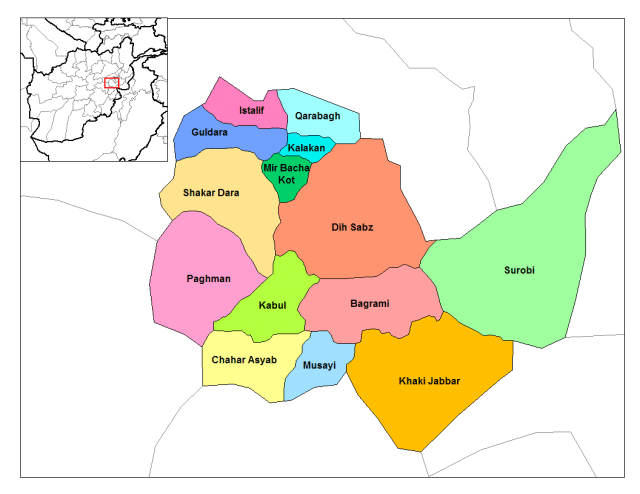 Areas of security in Kabul and the surrounding districts have allowed for improvements in development and governance.
Areas of security in Kabul and the surrounding districts have allowed for improvements in development and governance.
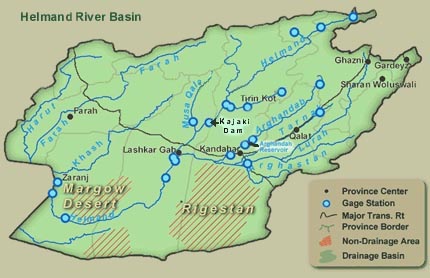 Progress is also visible in areas where Coalition forces have been on the ground for more than six months, such as Central Helmand Province.
Progress is also visible in areas where Coalition forces have been on the ground for more than six months, such as Central Helmand Province.
Socio-economic development throughout the country is slowly improving, as the Afghan Government shows initial signs of improving essential service delivery, although it is limited still by the security environment in some areas.
Overall governance and development progress continues to lag security gains.
Agricultural development and productivity has also improved. Overall governance and development progress continues to lag security gains. Governance capacity and economic development are long-term efforts that will require sustained support from the international community.
Key strategic events
Included the U.S.-Afghanistan Strategic Dialogue in May, the National Consultative Peace Jirga in June, the Kabul Conference in July, and the Afghan Parliamentary elections in September. This period also saw the arrival of U.S. [SURGE] forces in theater, along with more than three-fourths of the pledged North Atlantic Treaty Organization (NATO) [SURGE] forces and remarkable growth of Afghan National Security Forces (ANSF) by about one third since November 2009. This period included several important political developments including President Hamid Karzai’s approval of the Peace and Reintegration Program (APRP), a Presidential decree establishing the Afghan Local Police (ALP), the signing of the Afghanistan-Pakistan Transit Trade Agreement, and the establishment of the Joint Afghan-NATO Inteqal (“transition”) Board (JANIB).
Page 7
Increase in Violence
The increase in violence during this period was concurrent with the arrival of Coalition personnel, the dramatically accelerated pace of operations, and the spike of violence often seen on Election Day. The International Security Assistance Force (ISAF) is seeing some early indications that counterinsurgency operations are having localized positive effects and are producing initial signs of progress. Indications of local resistance to insurgents continue to emerge alongside positive indications, such as newly opened schools and police stations.
ISAF and ANSF [Afghan] forces gradually are pushing insurgents to the edges of secured population areas, in a number of important locations. The Afghan Government and ISAF continue to face a resilient enemy that exploits governance gaps and continues to fight to retain long-standing sanctuaries where the insurgency historically has had strong roots. Yet, the insurgent-generated violence remains largely localized and does not threaten all of Afghanistan: 45 percent of all violence and two-thirds of all improvised explosive device (IED) activity take place in the south.
General Petraeus takes Command
After taking command as Commander ISAF (COMISAF) and Commander U.S. Forces-Afghanistan (COMUSFOR-A) on July 4, 2010, General Petraeus issued a revised Tactical Directive. This directive provides guidance and intent for the employment of force. In addition, General Petraeus issued refined counterinsurgency (COIN) guidance to reinforce the principles of conducting COIN operations in Afghanistan, and new COIN contracting guidance to reinforce that contracting is “commanders’ business” and that commanders must understand the effects of contract spending.
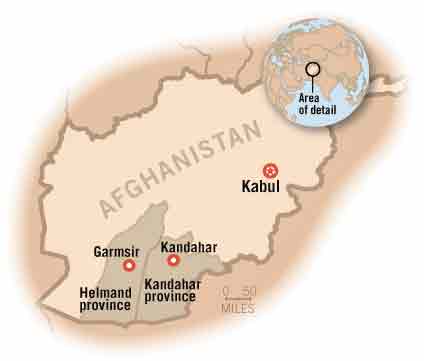 The ISAF operational main effort is focused on protecting the most threatened population in the heart of the Taliban-led insurgency in Helmand and Kandahar Provinces. The split of Regional Command-South (RC-S) and Regional Command-Southwest (RC-SW) on June 14, 2010 has allowed for more effective and streamlined [ISAF-ANSF] command and control and improved ANSF partnering in both provinces. Civil-military efforts in RC-S and RC-SW are making slow but steady progress. Initial signs of this progress are evident especially in Central Helmand, where ISAF and ANSF have been conducting counterinsurgency operations for over a year.
The ISAF operational main effort is focused on protecting the most threatened population in the heart of the Taliban-led insurgency in Helmand and Kandahar Provinces. The split of Regional Command-South (RC-S) and Regional Command-Southwest (RC-SW) on June 14, 2010 has allowed for more effective and streamlined [ISAF-ANSF] command and control and improved ANSF partnering in both provinces. Civil-military efforts in RC-S and RC-SW are making slow but steady progress. Initial signs of this progress are evident especially in Central Helmand, where ISAF and ANSF have been conducting counterinsurgency operations for over a year.
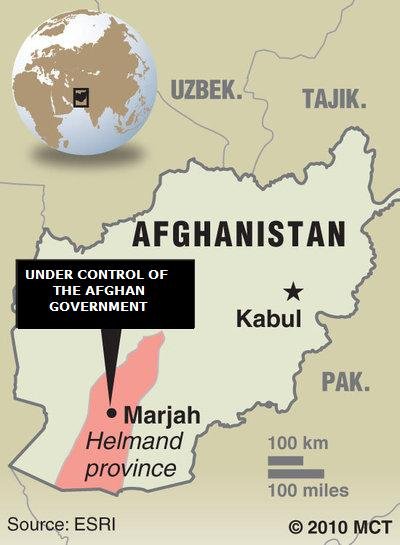 Progress: Despite the enemy’s continued efforts to counter coalition and ANSF actions to expand security in the south, slow and incremental gains are being achieved. Six months ago, Marjah was an insurgent command-and-control center, a base for IED assembling, and a nexus for illegal narcotics industry activities. Now the city is controlled by the Afghan Government. Signs of progress in Marjah include voter registration, increased activity in local marketplaces, and the reopening of schools that were closed for several years.
Progress: Despite the enemy’s continued efforts to counter coalition and ANSF actions to expand security in the south, slow and incremental gains are being achieved. Six months ago, Marjah was an insurgent command-and-control center, a base for IED assembling, and a nexus for illegal narcotics industry activities. Now the city is controlled by the Afghan Government. Signs of progress in Marjah include voter registration, increased activity in local marketplaces, and the reopening of schools that were closed for several years.
Relatively secure environment for the people of Kabul and the surrounding districts,
Combined ISAF and ANSF Forces in Regional Command-Capital (RC-C) continued to sustain a relatively secure environment for the people of Kabul and the surrounding districts, where approximately one-sixth of all Afghans live. Combined Afghan security forces in Kabul performed notably well in the planning and the execution of security for the Peace Jirga and the Kabul Conference, as well as during Parliamentary elections. Indeed, the transition of key security functions and responsibilities already occurring in RC-C is similar to that which is envisioned to occur across the country in the coming years.
In the coming months, ISAF will focus on expanding security from Kabul into surrounding provinces, particularly in Regional Command-East (RC-E). ISAF operations in RC-E have continued to apply pressure and disrupt the leadership of the Haqqani and Taliban Networks. Combined forces in RC-E are securing critical lines of communication and infrastructure that supports the commerce to and from Pakistan. Efforts in RC-E will further increase the pressure on some of Afghanistan’s most lethal enemy networks, expand population security from Kabul to key population centers in Wardak and Logar [south of Kabal], neutralize the Haqqani Network’s footholds and disrupt its access to Kabul, and secure the main economic border crossing point at Torkham.
The insurgency has failed to gain significant footholds
Despite recent high-profile events, the insurgency has failed to gain significant footholds in Regional Command-North (RC-N) and Regional Command-West (RC-W). ISAF and ANSF efforts have benefitted from expanded partnering and remain focused on improving security in key terrain districts and ensuring gradually improving freedom of movement along Highway 1.
Afghan National Security Force [ANSF] growth and development are among Afghanistan’s most promising areas of progress.
The ANSF has, at times, been considered one of the greatest risk areas of the ISAF strategy. As of the end of this reporting period, ANSF growth and development are among Afghanistan’s most promising areas of progress, though numerous challenges persist. In July 2010, the Afghan National Army (ANA) and the Afghan National Police (ANP) both met their growth goal of 134,000 and 109,000 personnel, respectively, three months before the target date of October 31. The ANA end strength for July was 134,028 personnel, and the ANP end strength was 115,525 personnel. If the ANA and ANP continue to grow at a similar pace, which will be challenging, they will also meet their October 2011 goals of 171,600 and 134,000 personnel, respectively. Although the growth during this reporting period is significant, improving the quality of the force remains a serious challenge, in particular in the area of leadership development. Also, given the expanded requirements described in the Combined Joint Statement of Requirements, released on September 1, NATO Training Mission-Afghanistan will face a shortfall of ANSF trainers and mentors that will grow more acute through the fall and into next year, if troop contributions do not meet the growing need for training. If not adequately addressed, this shortfall poses significant strategic risk and threatens to delay the upcoming [2011] transition process.
Leader shortfalls in the officer and non-commissioned officer (NCO) Corps of the ANA will remain as the force grows, and low literacy rates and lack of technical expertise present challenges to force development. Mandatory literacy training and the establishment of branch specialty schools will begin to alleviate some of this challenge, and aggressive partnering is starting to address development deficits. Significant shortfalls in specialist instructor pledges, if persistent past this year’s force generation process, will delay transition of institutional capacity. The ANP reached its 2010 growth objective of 109,000 three months early, but the severe attrition rate in Afghan National Civil Order Policy (ANCOP) puts the 2011 growth goal of 134,000 at risk as 90 percent of programmed growth this coming year is in the ANCOP.
In August, President Karzai authorized the establishment of the Afghan Local Police (ALP) program. ALP is a temporary, village-focused program that complements counterinsurgency efforts by targeting select areas with limited or no ANSF presence to shape security conditions and allow for improved governance and development. In September, the Afghan Government approved ALP at 68 sites and established the first eight ALP sites. We anticipate the establishment of most of the remaining ALP sites by the end of 2010. Page 9
Afghan government corruption continues to fuel the insurgency in various areas
As President Karzai has recognized, corruption continues to fuel the insurgency in various areas. ISAF, in coordination with the international community and the Afghan Government, established the Combined Joint Interagency Task Force (CJIATF)-Shafafiyat (“Transparency”) to develop a common understanding of corruption, to support Afghan-led anti-corruption efforts, and to integrate ISAF anti-corruption activities with those of key partners. CJIATF-Shafafiyat achieved initial operational capability in late August, with full operational capability expected in October 2010.
Karzai Administration has improved its stance against corruption
The U.S. Embassy-Kabul, U.S. Agency for International Development (USAID), and ISAF, together with the United Nations Mission in Afghanistan (UNAMA) and non-governmental organizations (NGOs), continues to work with the Afghan Government to help improve governance and accelerate development. The Karzai Administration has improved its stance against corruption by prosecuting several high-profile senior officials. However, progress remains uneven and incremental. The Afghan Government also has improved inter-ministerial coordination, but faces several challenges and has yet to establish unified control over border control and customs – one of the primary sources of government revenue. The Kabul Bank episode continues to foster uncertainty in the financial sector and poses potential threats to investment and economic growth.
Readers are more than welcome to use the articles I’ve posted on Veterans Today, I’ve had to take a break from VT as Veterans Issues and Peace Activism Editor and staff writer due to personal medical reasons in our military family that take away too much time needed to properly express future stories or respond to readers in a timely manner.
My association with VT since its founding in 2004 has been a very rewarding experience for me.
Retired from both the Air Force and Civil Service. Went in the regular Army at 17 during Vietnam (1968), stayed in the Army Reserve to complete my eight year commitment in 1976. Served in Air Defense Artillery, and a Mechanized Infantry Division (4MID) at Fort Carson, Co. Used the GI Bill to go to college, worked full time at the VA, and non-scholarship Air Force 2-Year ROTC program for prior service military. Commissioned in the Air Force in 1977. Served as a Military Intelligence Officer from 1977 to 1994. Upon retirement I entered retail drugstore management training with Safeway Drugs Stores in California. Retail Sales Management was not my cup of tea, so I applied my former U.S. Civil Service status with the VA to get my foot in the door at the Justice Department, and later Department of the Navy retiring with disability from the Civil Service in 2000.
I’ve been with Veterans Today since the site originated. I’m now on the Editorial Board. I was also on the Editorial Board of Our Troops News Ladder another progressive leaning Veterans and Military Family news clearing house.
I remain married for over 45 years. I am both a Vietnam Era and Gulf War Veteran. I served on Okinawa and Fort Carson, Colorado during Vietnam and in the Office of the Air Force Inspector General at Norton AFB, CA during Desert Storm. I retired from the Air Force in 1994 having worked on the Air Staff and Defense Intelligence Agency at the Pentagon.
ATTENTION READERS
We See The World From All Sides and Want YOU To Be Fully InformedIn fact, intentional disinformation is a disgraceful scourge in media today. So to assuage any possible errant incorrect information posted herein, we strongly encourage you to seek corroboration from other non-VT sources before forming an educated opinion.
About VT - Policies & Disclosures - Comment Policy



